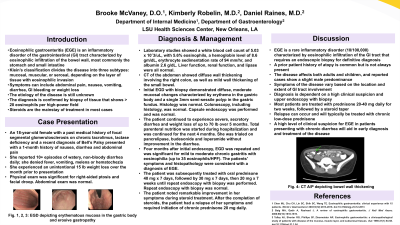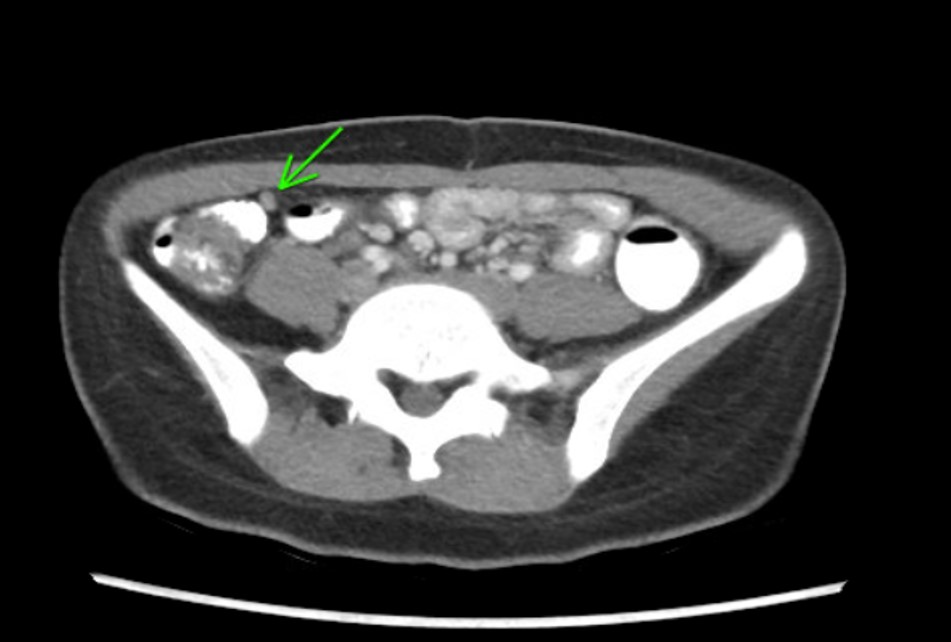Tuesday Poster Session
Category: Small Intestine
P4962 - Eosinophilic Gastroenteritis, An Underrecognized Source of Chronic Diarrhea
Tuesday, October 29, 2024
10:30 AM - 4:00 PM ET
Location: Exhibit Hall E

Has Audio
- BM
Brooke McVaney, DO
LSU Health New Orleans School of Medicine
New Orleans, LA
Presenting Author(s)
Brooke McVaney, DO1, Kimberly Robelin, MD1, Salim C.. Lutfallah, BS2, Daniel Raines, MD3
1LSU Health New Orleans School of Medicine, New Orleans, LA; 2LSU Health New Orleans School of Medicine, Metairie, LA; 3Louisiana Health Sciences Center New Orleans, New Orleans, LA
Introduction: Eosinophilic gastroenteritis (EGE) is an inflammatory disorder of the gastrointestinal (GI) tract characterized by eosinophilic infiltration of the bowel wall, most commonly the stomach and small intestine. Symptoms can include abdominal pain, nausea, vomiting, diarrhea, GI bleeding or weight loss. The etiology of the disease is unknown. Diagnosis is confirmed by biopsy of tissue that shows > 20 eosinophils per high-power field.
Case Description/Methods: An 18-year-old female presented with a 1-month history of nausea, diarrhea and abdominal pain. She reported 10+ episodes of watery, non-bloody diarrhea associated with urgency and nocturnal awakenings daily. She endorsed a chronic sensation of nausea and cramping, generalized abdominal pain exacerbated by eating, as well as an unintentional 15 lb weight loss. No fever or vomiting was reported.
Abdominal exam was normal. Laboratory studies showed a white blood cell count of 5.03 x 10ˆ3/uL, with 5.6% eosinophils, and erythrocyte sedimentation rate of 94 mm/hr. Liver function, renal function and lipase were normal. CT of the abdomen showed diffuse wall thickening involving the right colon, and mild wall thickening of the small bowel. EGD with biopsy demonstrated diffuse, moderate mucosal changes characterized by erythema in the gastric body. Histology was normal. Colonoscopy and capsule endoscopy were normal.
The patient continued to experience severe, secretory diarrhea and weight loss of up to 70 lb over 5 months, necessitating initiation of total parenteral nutrition. She was trialed on budesonide and loperamide without improvement. Four months after initial endoscopy, EGD was repeated and was significant for mild to moderate chronic gastritis with eosinophilia (up to 35 eosinophils/HPF).
The patients' symptoms and histopathology were consistent with a diagnosis of EGE. The patient was subsequently treated with an oral prednisone taper for 7 weeks until repeat endoscopy with biopsy was performed and demonstrated resolution of gastritis and eosinophilia. She noted remarkable improvement in her symptoms during steroid treatment.
Discussion: EGE is a rare inflammatory disorder (10/100,000) characterized by eosinophilic infiltration of the GI tract that requires an endoscopic biopsy for definitive diagnosis. Symptoms of the disease vary based on the location and extent of GI tract involvement. A high level of clinical suspicion for EGE in patients presenting with chronic diarrhea will aid in early diagnosis and treatment of the disease.

Disclosures:
Brooke McVaney, DO1, Kimberly Robelin, MD1, Salim C.. Lutfallah, BS2, Daniel Raines, MD3. P4962 - Eosinophilic Gastroenteritis, An Underrecognized Source of Chronic Diarrhea, ACG 2024 Annual Scientific Meeting Abstracts. Philadelphia, PA: American College of Gastroenterology.
1LSU Health New Orleans School of Medicine, New Orleans, LA; 2LSU Health New Orleans School of Medicine, Metairie, LA; 3Louisiana Health Sciences Center New Orleans, New Orleans, LA
Introduction: Eosinophilic gastroenteritis (EGE) is an inflammatory disorder of the gastrointestinal (GI) tract characterized by eosinophilic infiltration of the bowel wall, most commonly the stomach and small intestine. Symptoms can include abdominal pain, nausea, vomiting, diarrhea, GI bleeding or weight loss. The etiology of the disease is unknown. Diagnosis is confirmed by biopsy of tissue that shows > 20 eosinophils per high-power field.
Case Description/Methods: An 18-year-old female presented with a 1-month history of nausea, diarrhea and abdominal pain. She reported 10+ episodes of watery, non-bloody diarrhea associated with urgency and nocturnal awakenings daily. She endorsed a chronic sensation of nausea and cramping, generalized abdominal pain exacerbated by eating, as well as an unintentional 15 lb weight loss. No fever or vomiting was reported.
Abdominal exam was normal. Laboratory studies showed a white blood cell count of 5.03 x 10ˆ3/uL, with 5.6% eosinophils, and erythrocyte sedimentation rate of 94 mm/hr. Liver function, renal function and lipase were normal. CT of the abdomen showed diffuse wall thickening involving the right colon, and mild wall thickening of the small bowel. EGD with biopsy demonstrated diffuse, moderate mucosal changes characterized by erythema in the gastric body. Histology was normal. Colonoscopy and capsule endoscopy were normal.
The patient continued to experience severe, secretory diarrhea and weight loss of up to 70 lb over 5 months, necessitating initiation of total parenteral nutrition. She was trialed on budesonide and loperamide without improvement. Four months after initial endoscopy, EGD was repeated and was significant for mild to moderate chronic gastritis with eosinophilia (up to 35 eosinophils/HPF).
The patients' symptoms and histopathology were consistent with a diagnosis of EGE. The patient was subsequently treated with an oral prednisone taper for 7 weeks until repeat endoscopy with biopsy was performed and demonstrated resolution of gastritis and eosinophilia. She noted remarkable improvement in her symptoms during steroid treatment.
Discussion: EGE is a rare inflammatory disorder (10/100,000) characterized by eosinophilic infiltration of the GI tract that requires an endoscopic biopsy for definitive diagnosis. Symptoms of the disease vary based on the location and extent of GI tract involvement. A high level of clinical suspicion for EGE in patients presenting with chronic diarrhea will aid in early diagnosis and treatment of the disease.

Figure: CT A/P depicting bowel wall thickening.
Disclosures:
Brooke McVaney indicated no relevant financial relationships.
Kimberly Robelin indicated no relevant financial relationships.
Salim Lutfallah indicated no relevant financial relationships.
Daniel Raines indicated no relevant financial relationships.
Brooke McVaney, DO1, Kimberly Robelin, MD1, Salim C.. Lutfallah, BS2, Daniel Raines, MD3. P4962 - Eosinophilic Gastroenteritis, An Underrecognized Source of Chronic Diarrhea, ACG 2024 Annual Scientific Meeting Abstracts. Philadelphia, PA: American College of Gastroenterology.
